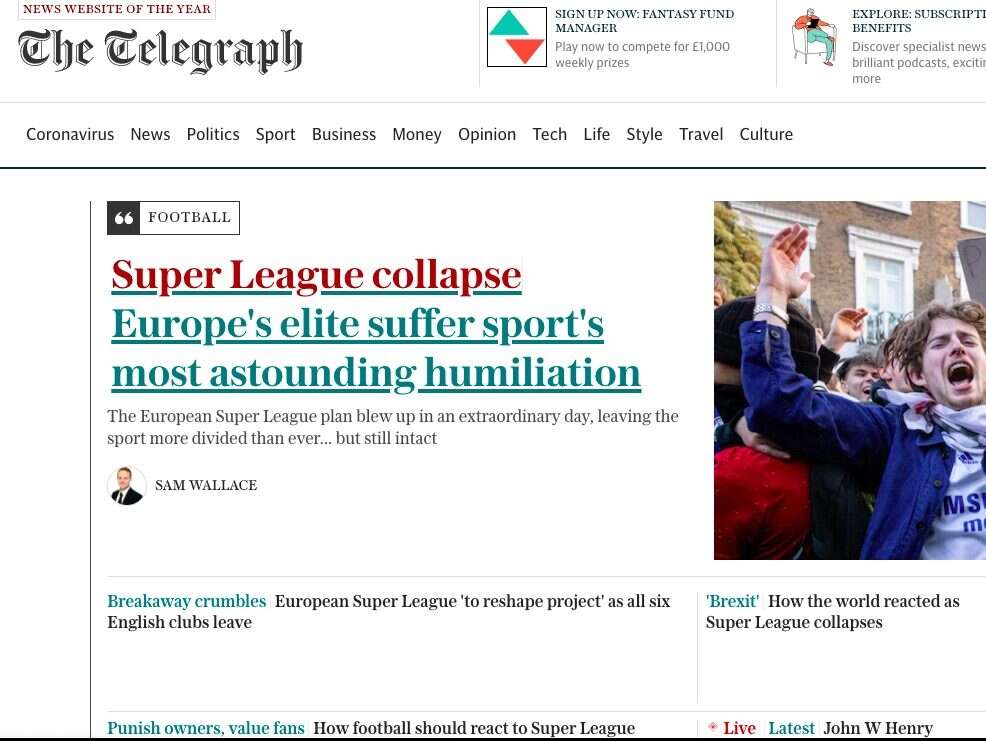
Established and mainstream news sites saw the biggest global month-on-month gains in traffic in March, according to Press Gazette’s analysis of visits to the world’s most popular English-language news websites.
The telegraph.co.uk was the fastest growing site in March, with month-on-month visits up 20% from 53 million to 64 million. It was followed by another UK newsbrand, thetimes.co.uk which saw visits increase 18% from 36 million to 42 million, according to data from web analytics company SimilarWeb.
Among the sites that saw the biggest month-on-month falls in traffic were two politics-focused news sites – thehill.com and politico.com – and news-based social video platform BitChute, which has been described as a right-wing alternative to YouTube.
In contrast to recent months, where right-leaning and alternative news sites have seen the biggest relative audience growth, it was mostly established and mainstream brands that saw the biggest year-on-year traffic gains this time for most popular news websites. The big exception was BitChute which – despite seeing traffic fall between February and March – stands alone in the top ten for year-on-year growth. The platform’s visits were up 144% compared to last March, as monthly visits increased from 15.3 million to 37.6 million this March.
Hellomagazine.com, thetimes.co.uk and Associated Press’ site APnews.com also saw significant growth in year-on-year visits. Monthly visits to hellomagazine.com were up 134% from 25 million to 59 million while visits to thetimes.co.uk increased from 25.6 million to 42.4 million (up 64%).
Overall, the current top 50 most popular news websites saw a combined 3% more visits in March (6.1 billion) versus February (5.9 billion), although traffic remains significantly lower than the peak of 8.5 billion combined visits in November 2020. November both saw the US elect a new president and a worsening of the Covid-19 pandemic in many parts of the world.
March 2021’s year-on-year decline in traffic is also much more significant than we have reported in previous months’ analyses. Year-on-year traffic fell 19% to 6 billion combined visits, down from 8.5 billion in March 2020 when there was a surge in visits to many news sites as a result of the scramble for information with the start of the Covid-19 pandemic.
As reported by Press Gazette earlier this month, untrustworthy news sites – many with a strongly conservative or right-wing slant – have seen bigger relative increases in traffic since the pandemic took hold in March 2020.
BBC.co.uk and BBC.com combined came out on top with 1.27 billion website visits in March. This was 9% more than in February but 2% lower than in March 2020 when both sites combined received 1.3 billion visits.
Next most-viewed was CNN with 687 million sessions on its websites (CNN.com and edition.CNN.com) – 3% lower than the 710 million visits that CNN’s two sites received in February.
The next largest websites belonged to the New York Times (377 million visits, down 34% year-on-year), Mail Online (338 million, down 10%), Yahoo! Finance (328 million visits, up 19%), the Guardian (317 million visits, down 27%) and Fox News (275 million, down 33%).
Where does major news website traffic come from?
The SimilarWeb report for Press Gazette also examined the source of online traffic for the largest English-language news outlets.
The majority of visits to large websites continued to be either direct – i.e. web users go straight to them – or originate from online searches.
As in February, right-wing news aggregator Drudge Report came out on top for direct visits (90%). It was followed by Breitbart (78%) and Bitchute.com (72%). Once again, among the sites with the lowest proportion of users arriving directly were US News (10%) and Forbes (14%) which instead received most traffic through organic search – i.e. unpaid search results.
Top for organic search were US News (87%), Cosmopolitan (83%), Hello magazine (75%) and Forbes (74%).
Paid search, when site owners pay to appear high up in search engine results, accounted for very few visits to the top news sites. Only a handful of news sites, among them Bloomberg and Australia’s ABC and thetimes.co.uk used paid search at all. Even then, paid results accounted for less than 1% of their traffic.
Facebook was the main social media referrer for most news websites coming out as the number one source for 42% of sites in the top 50 – putting it significantly ahead of second-place Twitter which represented the top source of social media referrals for 30% of sites.
Email pged@pressgazette.co.uk to point out mistakes, provide story tips or send in a letter for publication on our "Letters Page" blog
